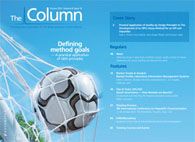Quality control
Malaria is one of the biggest killers in the developing world. In order to wage war on this disease the quality of the drugs that are available must be of the highest possible.

Malaria is one of the biggest killers in the developing world. In order to wage war on this disease the quality of the drugs that are available must be of the highest possible. However, quality control of drugs in formulations is still a major challenge in developing countries. A team of scientists has therefore conducted an experiment using capillary electrophoresis to perform quality control on commercial fixed-dose combination tablets.1
The team used a micellar electrokinetic capillary chromatography method (MEKC) to determine artesunate and amodiaquine hydrochloride. Analytes were extracted from tablets by sonication with a solvent mixture phosphate buffer pH 7.0 acetonitrile containing benzoic acid as internal standard.
Artesunate, amodiquine and benzoic acid were separated in 6 min. The method was found to be reliable in terms of specificity, linearity of the calibration line, recovery from synthetic tablets and repeatability.
However, the main benefit of the method was the low cost of the capillary itself, its long lifetime and the low consumption of separation electrolyte. The team concluded that the method is very well-suited for drug quality control and the detection of counterfeit or substandard medicines.
1. Fabre et al., Malaria Journal11(149) doi:10.1186/1475-2875-11-149 (2012).
This story originally appeared in The Column. Click here to view that issue.


.png&w=3840&q=75)

.png&w=3840&q=75)



.png&w=3840&q=75)



.png&w=3840&q=75)










